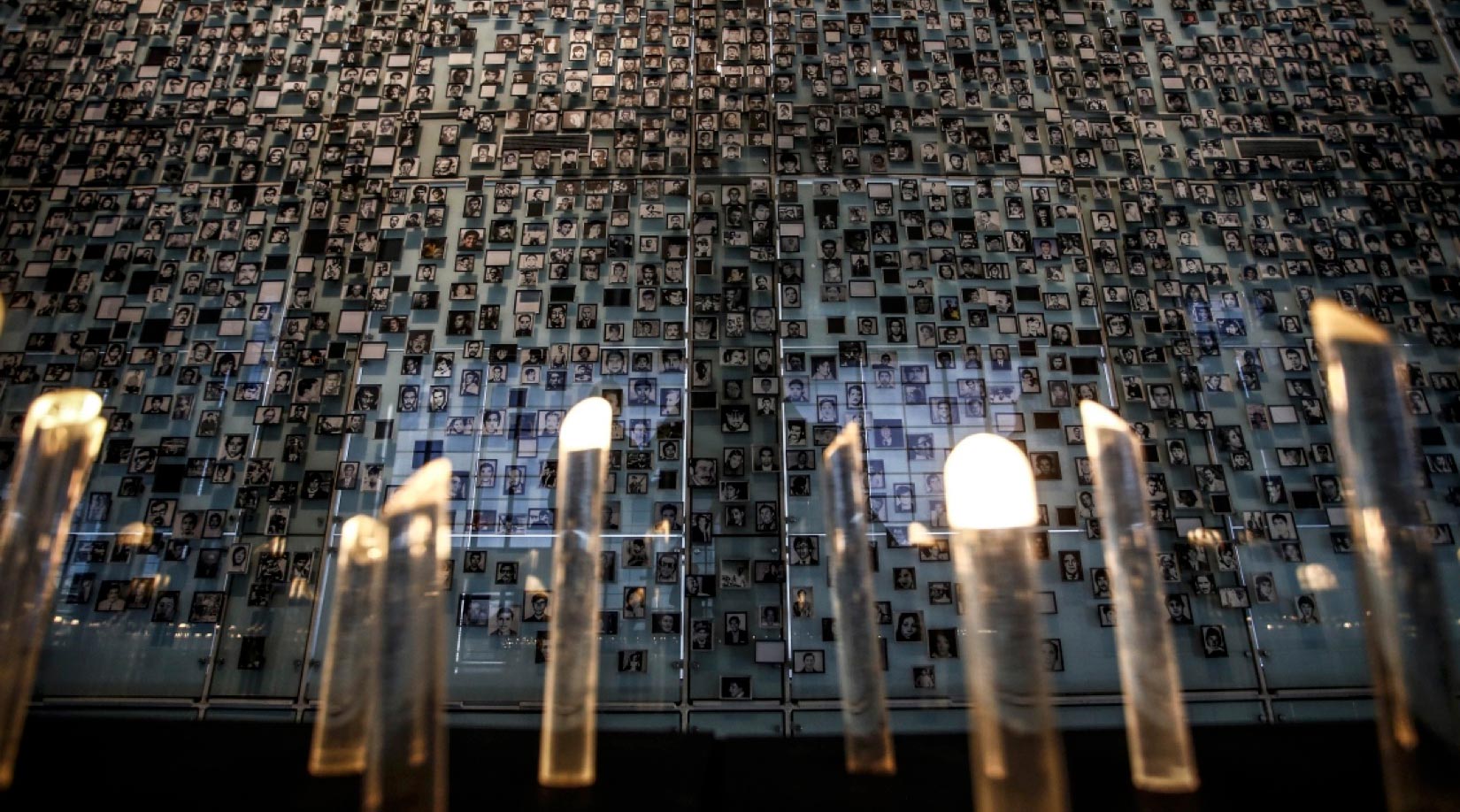
Bringing to Light: Visual Testimonies of Survival1
Carolina Pizarro Cortés
The focus of this essay is a group of visual works produced in Chile and Argentina based on photographs of the missing during each country’s respective dictatorships, whether an intimate portrait, domestic image, or official-type of photograph such as that of an identity card. These are artistic interventions that do not necessarily have as their main objective testifying to absence, as was the case in the public protests carried out by the relatives of the victims. These works, this essay will argue, are part of a turn that reorients the sense of the testimonial use of the photo: bringing to the here and now those who were victims of the dictatorial repression in both countries, insisting on their presence. In the three cases explored here, it is possible to see the same basic operation at work, one that I propose as relational. This consists of placing the photograph, through a composite image, in direct connection with the family members. In this way, the emotional bond functions as the center of representation and as a guarantee of the survival of the disappeared person. In addition, the essay will note a progression in the use of techno-visual resources, as well as the similarly progressive intensification of intermediate dialogue.2
In both Chile and Argentina, victims’ families used the photo as a form of protest. They displayed their missing relatives in public space, carrying the images of their faces on their chests or on banners. At the time, it was a way of visually sustaining the identity of those who had lost both their citizen rights and their existence. Photography replaced the absent body. In several cases, even the ID photo: the face looking at the camera, without much expressiveness, with the full name and identification number included at the bottom. The official image is thus resignified to indicate that this person exists, is legal, and appears in records. The name-face-number triad is a guarantee of the victim’s being, denied by the nefarious practice of disappearance. The performative use of the photo in these acts of public denunciation testifies and exposes the absence of the referent.3
The three projects explored here build on the protest practice described above, but at the same time resignify it. The emphasis in these artistic exercises of projection is placed on survival, on the fact that these “hidden lives” – those of the victims and their relatives – continue to exist. Hence, we can read their meaning as a process of bringing to light, in a literal and figurative sense. Representation is used not only as a trace or imprint of someone who is no longer there, but also as material evidence of their presence. The image, moreover, allows for the fusion of dissimilar times, opening up an alternative reality that counteracts the fatal weight of history. The relationship between the missing person and his/her family is the nucleus that allows the connection between the past visual record and the present visual record.
The first of these exercises, carried out by the Argentine photographer Julio Pantoja, resulted in the photo essay and exhibition entitled Los hijos. Tucumán veinte años después [Children. Tucumán Twenty Years Later]. This series, comprising 38 images, portrays the sons and daughters of the disappeared who were victims of the repressive exercise of the Videla dictatorship in the northern province. The work was carried out between 1997 and 2001.4 It consists of a joint elaboration, in which the photographer dialogues with those portrayed to give form to the photograph that will represent them. Significantly, 15 of them choose to be photographed together with an image of one or both missing parents. Thus, an impossible family photo is composed, in which parents and children are approximately the same age. The minimal mise en abyme that takes place when introducing a photo inside another photo implies a homologation of materialities. There is no longer a separation between the image of the lost relative and the surviving person, but rather both are subsumed in a snapshot. The distance between reality and representation is thus broken.
In the context of this series, Pablo Gargiulo’s portrait is especially significant.
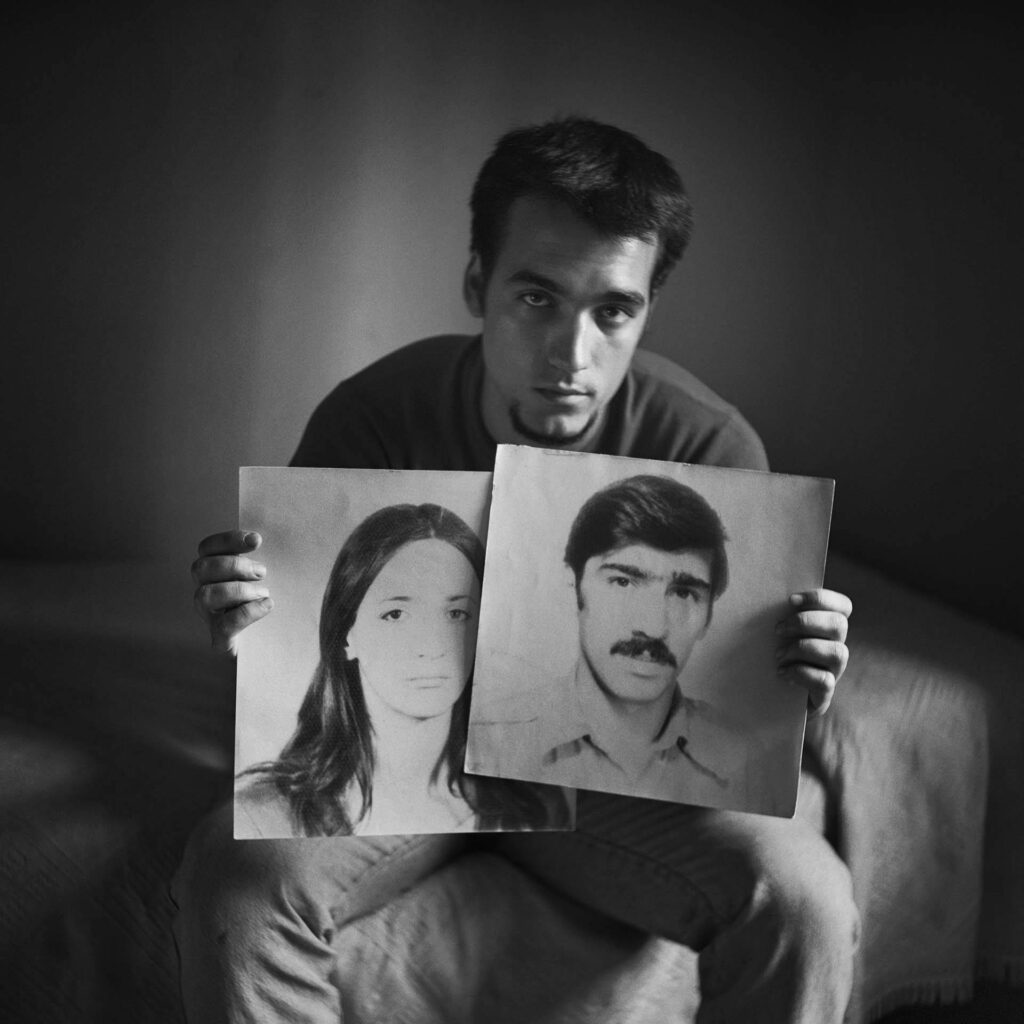
The young man poses with his mother’s photograph in his right hand and his father’s in his left. The frame composes a family photo from the conjunction of two old photos that are integrated to the new image. In this photograph no technical artifice is used: the young man simply holds two portraits at chest height, allowing his face to be seen over those of his parents. Nothing is done to hide the cut and the discontinuity. The photo obtained is in that sense fully realistic. The aesthetic details that draw our attention have to do with simple procedures. The backgrounds of the parents’ photographs are lighter, in contrast with the darker background of the image containing the child, and there is a triangular balance in the arrangement of the figures. The parents, specially illuminated, act as the base of a triangle, which supports the upper vertex where the child is. The photo thus shows the importance of the bond, the foundation of fatherhood and motherhood. Lives have been truncated, but not their meaning. This meaning is notably reinforced by the pose: the young man, holding the portraits in his hands, generates a kind of embrace. In this way the image brings the victims back into presence through a relational operation.
Another variant of the (re)composed family portrait option is that of Laura Romero.
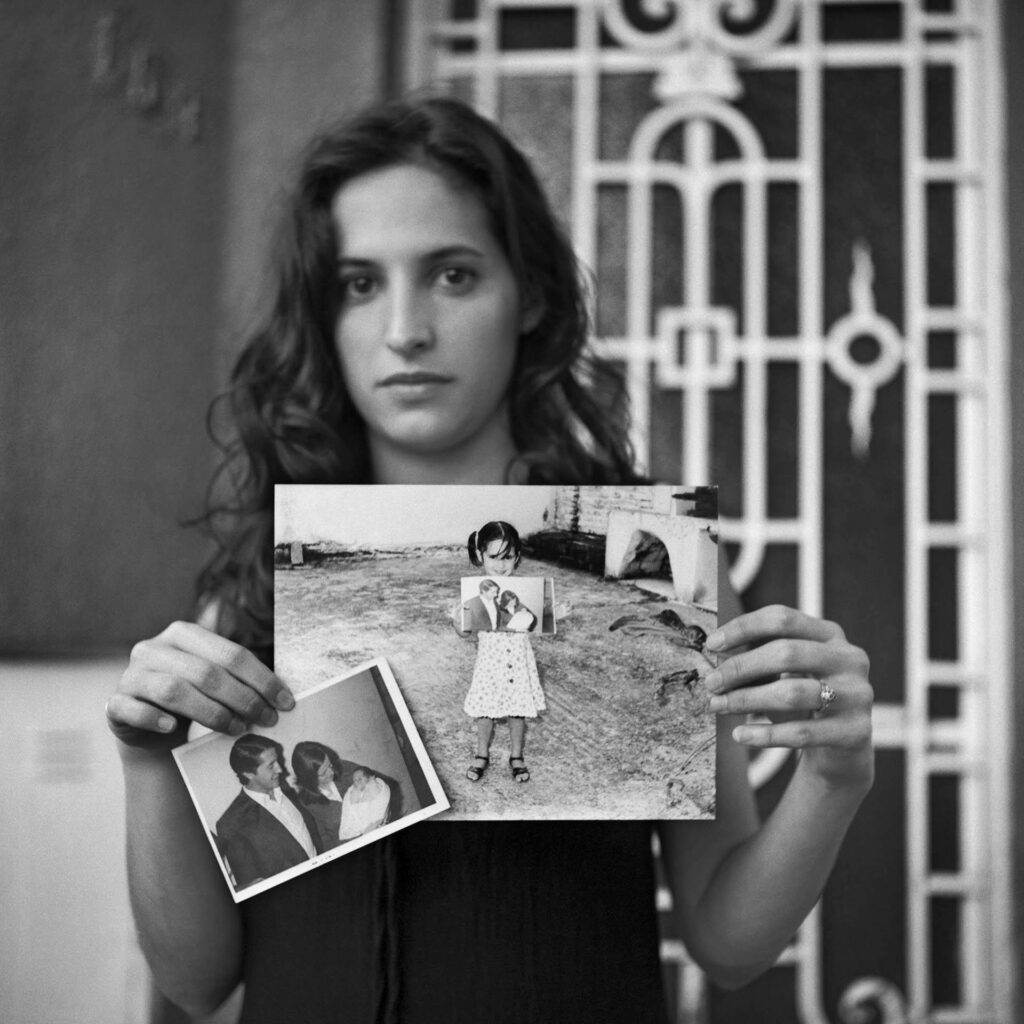
This is a photo of a young woman holding two slightly overlapping photographs: one shows her as a baby, with her parents, and the other shows her as a child, holding the previous photo. Symptomatically, the focus is on the previous photographs, so that they look sharp, while Laura’s face appears out of focus. The whole points to the contradictory superposition of temporal planes. It transmits the message of a constant accompaniment, the idea of a vital route marked by memory, but it is also an expression of cuts and discontinuities. The fact that Laura is presented by the three images,5 in different moments of her life, points to the permanence of the bond. The photos that she carries in her hands, however, are temporary capsules delimited by their own frames. The absence of an artifice that simulates coexistence brings us back to the fact that the process is constructive: it consists of threading together fragments. The very self of the one photographed is affected by the quality of the mosaic. Being the daughter of disappeared detainees means having to insist on maintaining family bonds.
The second creative exercise I would like to discuss, also based on the photos of the disappeared, is the project Arqueología de la ausencia [Archaelogy of Absence] by the artist Lucila Quieto. In an effort to complete her truncated family album, the product of her father’s disappearance a few months after her birth, Lucila devised a procedure to generate the images she never had. She projected old photos on a wall and then photographed herself taking part in the scenes, integrating her profile with images of another time. Positively evaluating her experiment, she made an open invitation to other sons and daughters of victims. The set of their images and of people who joined her initiative correspond to the 35 photographs of Arqueología de la ausencia (1999-2001).
As in Hijos…, in Arqueología… the representation of the lost link is generated through an overlapping of records. In this case, however, such an operation implies an intermediate step. A photo is not included within another photo –in a micro mise en abyme or game of Chinese boxes–, but rather a more complex photograph is composed through projection. As in a shadow theater, the reflection of the slide creates a possibility for intervention, so that the child can interfere in the life of his/her parents, integrating him/herself into a scene. The times, again, are altered, but in reverse. If Pantoja’s photo essay brought the parents to the children’s present, Quieto’s brings the children to their parents’ past. The effect of the impossible is repeated: the coincidence of ages between both captured in the same image.
The use of superimposition is the basic procedure. The artist makes a kind of photomontage, but of an intermediate nature. By using projection, she generates effects, insofar as the bodies of the children are at the same time part of the reconstructed scene and the backdrop where the image of the parents is projected.6 Sometimes these depictions can be deciphered; in most cases, ghostly or surreal images are created that are difficult to interpret visually.
An example of this is a photo of Diego and his mother, Manuela Santucho, a lawyer who disappeared in 1976.

In the old photograph, Manuela appears to the right of the image, in what could be a gathering of friends or a party. She does not look directly into the camera. Her face is in a three-quarter position. Diego is integrated into the projection from the left side, in a plane that is perceived to be slightly closer to the lens. Some shadows are projected on his chest, which could be part of the original photo. His face, however, appears clearly defined. He does not look at the camera either, but at a point close to his mother’s gaze. At a glance, both are part of the same scene. The overlap leaves very subtle traces, generating the illusion of co-presence. The photomontage composition – a kind of second-degree photography – helps to achieve the effect. Manuela is in the center of the image and her son Diego comes to complete the frame, reinforcing the mother’s centrality. The lights and shadows also conspire: Manuela is especially illuminated, while Diego’s face is perceived as more somber. The presence of the disappeared is thus reinforced, as her image becomes sharper than that of her survivor.
Within the same series of Arqueología… there are other images, like those of Lucila herself that expose the traces of the artifice in a clearer way. These do not necessarily emphasize the reconstructive process, but the effect achieved, as stated above, is rather surrealistic.

The projection that gives rise to this photograph allows the author to integrate halfway into an already occupied space, by superimposing her figure on that of a group of people who seem to be passers-by on a busy street. To the left of the image is her father, Carlos Quieto, looking into the camera. She stands to the right and looks towards him. As in the previous case, the quality of the present of the disappeared is emphasized, and even more so. His image and body can be perceived with its defined contours. She, on the other hand, is blurred. The photographer’s white clothes serve as a screen on which part of the past scene is projected. Thanks to this, the whole image assumes a phantasmatic aura around her.7 The original scene is projected on and becomes part of her body while the image contains and frames that of a couple of women walking arm in arm towards the lens. The technique produces an effect of unreality: Lucila is there and she is not; she infiltrates, but she does not incorporate herself fully. The relational operation, in this example, seems to be half fulfilled.
A third artistic exercise developed for the exhibition Vivos recuerdos [Living Memories], commissioned by the Socialist Party of Chile, sets up a tension in the relations between photography and (dis)appearance. The project consists of a set of portraits based on a photo of the missing detainee with the appearance that he or she would possibly have had if he or she had continued to live 45 years later. For the elaboration of the images, different digital techniques are used that intervene in the photographs, generating the effect of aging. The result is once again an impossible image, which brings to the present not the image of the one who died, which is treasured as a memory, but an updated portrait, an “as if” the disappeared detainee were still present.
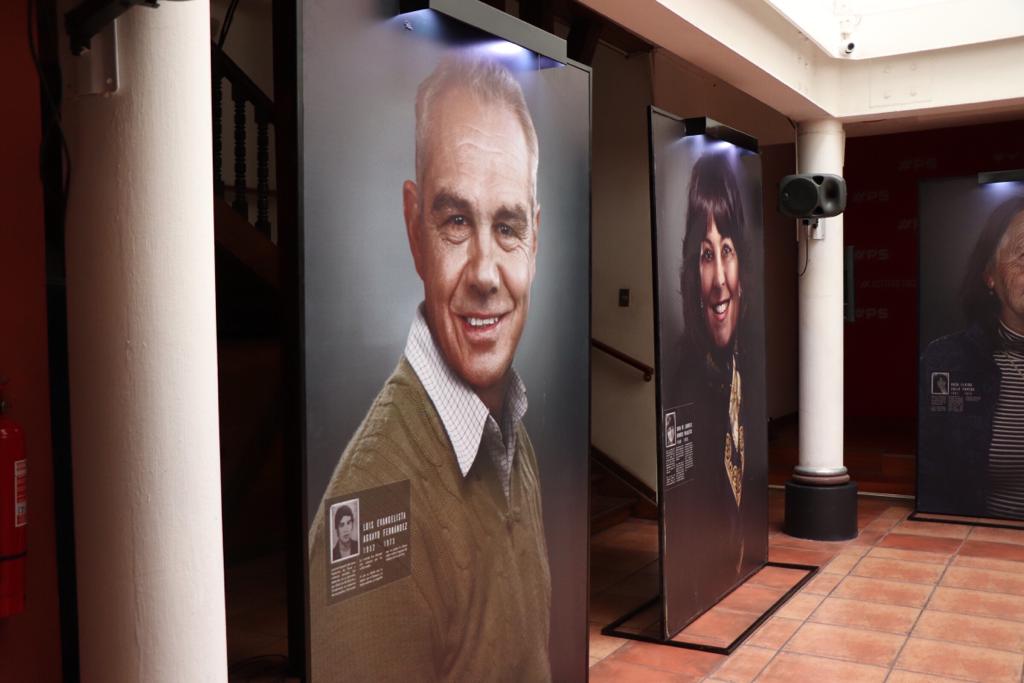
In addition to being presented as an exhibition, Vivos Recuerdos is available on a website8 of the same name and a video on the project was also produced.9 Both initiatives involve the producers Wolf BCPP, Ojo de Buey and SalaMágica, as well as the photographer Renato del Valle and musician Dario Segui. The intermediate transposition in the two “continuity exercises” generates resonant effects: the physical exhibition is projected and amplified in other media and supports. The basis is the same, but layers of meaning are added.
Site a https://vivosrecuerdos.cl
The website is very simple. The original photos of the faces of 10 missing militants are displayed on a black background. When you click on one of them, the aged portrait appears, taking up the whole screen. As in the images displayed in the exhibition, on the left is the basic photograph and a brief biography that tells who the person portrayed is and succinctly tells the details of their disappearance. The contact between the website and the user of the interface, unlike the exhibition, generates a narrative. The receiver enters through the real photo and can appreciate the transformation, the ‘passage of time.’ The new image also highlights the anchoring text – as Roland Barthes says10 – which, as is done succinctly in Hijos… and in a more detailed way in Arqueología…, allows us to know some biographical details that make the missing detainee unique.
The photographs taken in Vivos Recuerdos do not contain a relational dimension in and of themselves, as they do not expose any affective bond, but rather focus on the victim. The website promotes a certain interaction, but this, although undoubtedly more dynamic, is analogous to the experience of physically visiting the exhibition. It also involves a viewer who may not have any connection to the person portrayed. The audiovisual record, on the other hand, incorporates the relational dimension in the rescue of the image, giving it centrality.
The theme of the video is the first encounter of the victims’ relatives – spouses, siblings, children, nephews, and grandsons – with the portraits, exhibited for this purpose in the galleries of the Estadio Nacional.11 Before seeing the image, the relatives recall the personality of their relative and bring up details of their intimate life. The biography of each one of them appears in snippets in a conversation that is perceived as very spontaneous. Through language, the families contribute brushstrokes that humanize the absent one and begin to delineate him/her.
In one of these interventions, a young woman says: “The first approach toward my father is via the image: the banner, the photo. So my father has been a fragmented image, but also rich”.12 The daughter testifies from the place of someone who has only maintained a link with her father’s image through photography, remembering the form of visual protest that denounced his absence. The video thus incorporates a dialogue between the photo of the victim that the relatives carried for years on their chests or in their possession and the recomposition of the same image that claims the person’s presence.
After the remembrance the interviewees talk about how they think their relatives would look now. While their voices are heard, parts of the procedure by which the aged portraits of the victims were generated are briefly shown. The video then moves into the exhibition, following the families, to the stadium galleries. These galleries metonymically represent the places of detention, torture, and extermination from which their relatives disappeared. The journey through the dark galleries ends in front of the portrait. The video first shows the reactions of the relatives when they see the image of their family member and finally focuses on the faces of the disappeared. Some of them cry, others smile, others are stunned. For all of them there is a deep emotion. In the second order register – the video that brings together the present image of the victim and his or her direct relatives – the relational operation is central. The missing detainees become present to the extent that recognition occurs. People approach and touch the giant portraits; they express their desire to embrace them; they also kiss them. The narrative, in this case, decants as the story of a (im)possible encounter.
In the video there is very little text intervention. The written captions function as a voiceover that delivers only essential details of the image creation process and the recorded events. Among these texts, the final sentence stands out: “the only way not to repeat history is to keep the memory alive”. In a literal sense, the sentence reaffirms the conviction of the importance of not forgetting in order to prevent dire historical situations such as those of Chile’s recent past. In a second reading, complementarily, “keeping memory alive” means not letting the memory die and, with it, preserving from death or even rescuing from immobility those who have disappeared. To return them to the flow of time, as the intervened portraits do.
The three case studies presented here, that are in direct dialogue with the practice of the public display of the photo of the disappeared, not only demonstrate the assimilation of a testimonial resource of protest, but also make it more complex and amplify it. They take the photographs out of their place of registration of a subject, turning them into a representation of their emotional relationships. The first-degree image is integrated into a second-degree image, which produces the sensation – and perhaps also the feeling – of an encounter. In this process, as I noted at the beginning, it is possible to observe the complicit intervention of the photograph itself and then also of other media, that together make up a visual or audiovisual proposal that challenges the material reality of disappearance and does so by insisting on survival.
These three examples above are not exceptional cases, but are related to an important group of representations that have as their core the testimonial use of photography.13 It is interesting to highlight the particularity that distinguishes them: the focus on the relationship between those who are not here and those who survive. From this point of view, it could be argued that this is a specific corpus, which also motivates later initiatives.
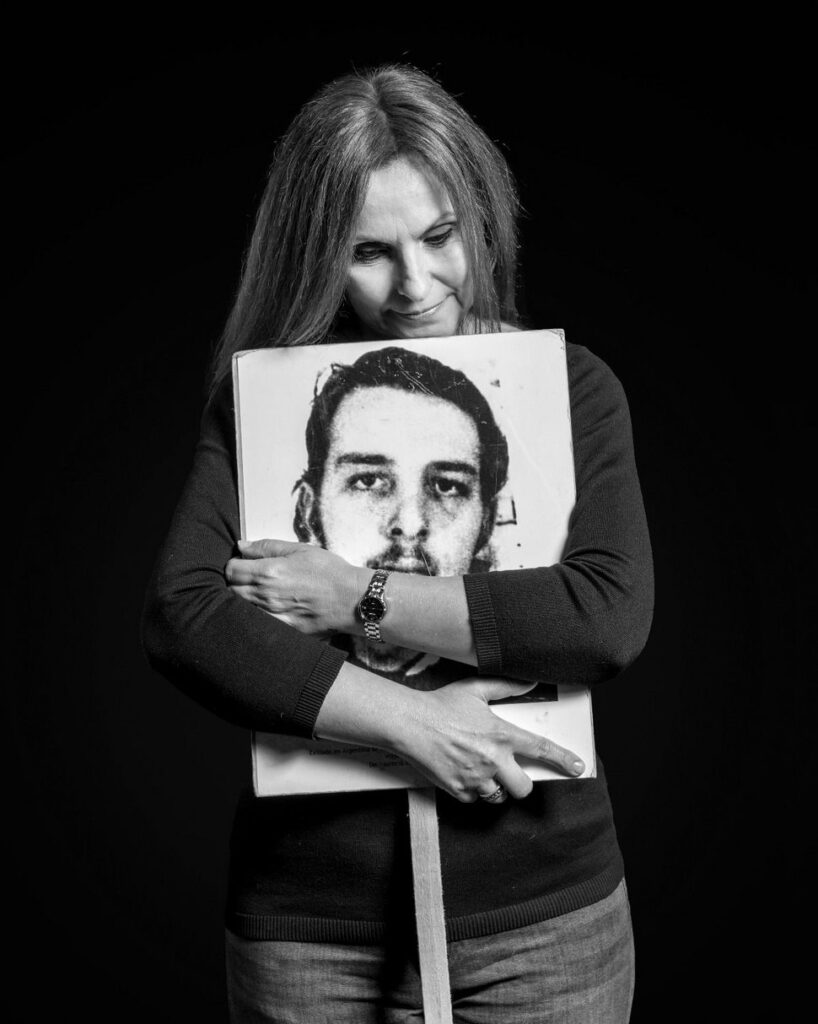
A very similar exercise to the one carried out by Pantoja and the sons and daughters of victims, for example, is proposed by Imágenes del silencio [Images of Silence], a collective Uruguayan project carried out between November 2019 and May 2020.14 It consists of black and white photographs in which a public figure holds or embraces a poster with a photo of a disappeared detainee printed on it. According to the times, it is uploaded to social networks, specifically Instagram, Twitter, and Facebook. Every day, as a countdown, a new image is included. In this case, “intermediality” reinforces the relational operation: it places the missing person in a new space of sociability, that of virtual platforms, and thus contributes to intensify their presence, almost in the form of dissemination. If it is true that the Internet era has allowed for the unveiling of the hidden, avoiding the logic of the information control of official channels, it is possible that the truncated life trajectories, destined through extreme repression to disappearance, emerge insistently. The call for connection, the appeal to empathy, moreover, has a much greater scope, inasmuch as it does not depend on material conditioning factors such as the acquisition of a book or attendance at an exhibition. The image of someone who remains in the memory and affections of his or her family members can go viral. Their existence, in this way, is not only maintained, but multiplied.
***
Carolina Pizarro Cortés
Holds Bachelors and Masters Degrees in Literature from the Universidad Católica de Chile and Doctorate in Philosophy from the Universität Konstanz, Germany. She completed a postdoctoral degree at the Instituto de Estudios Avanzados (Institute of Advanced Studies) of the Universidad de Santiago de Chile where she now works as a full-time academic. Her main publications include: Nuevos cronistas de Indias. Historia y liberación en la narrativa latinoamericana contemporánea (author, Colección IDEA, 2015), Revisitar la catástrofe: la prisión política en el Chile dictatorial (editor, Pehuén editores, 2016) y Nuevas formas del testimonio (editor, Colección IDEA – Editorial USACH, 2020, forthcoming).
1 This essay is part of the Fondecyt research project No. 1180001, “Tortura: experiencia y concepto” (“Torture: experience and concept”).
2 The concept of intermediality that we use in this work is the one coined by Irina Rajewsky (2005): “‘Intermedial’ (…) designates those configurations which have to do with a crossing of borders between media, and which thereby can be differentiated from intramedial phenomena as well as from transmedial phenomena (i.e., the appearance of a certain motif, aesthetic, or discourse across a variety of different media).” The author recognizes three forms of intermediality: (1) medial transposition, related to the way in which a medial product becomes such, either with the transformation of a given medial product (a text, a film, etc.) ) or of its substrate in another medium; (2) medial combination, in which the intermediate quality is given by the medial constellation that constitutes a given product, which is the result of a process of combination of at least two different media, and (3) medial references, in which the medial product uses its own specific medial modes, either to refer to an individual work produced in another medium, or to refer to a specific medial subsystem or to another medium as a system. Rather than combining different medial modes of articulation, the medial product thematizes, evokes or imitates elements or structures from another conventional medium (Irina Rajewsky, “Intermediality, Intertextuality, and Remediation: A Literary Perspective on Intermediality- Intermédialités, 6, 2005, pp. 43-64). In the cases analyzed in this essay what can be mostly observed from the technical point of view is medial combination (no.2), but there can also be seen important medial reference (no.3) components.
3 Ludmila da Silva explains the meaning of these photographs used by relatives during the Argentine dictatorship. At first, “The photo with the face of the disappeared became […] a search tool, a hope in the face of uncertainty. […] It was a strategy to identify the loved one whose fate was unknown.” It then becomes, in the context of the trials, an indicative resource for the search for truth. Finally, it became part of the active protest in public spaces: “As the years passed, the creation of symbols and rituals accompanied this new form of politics instituted by the relatives of the disappeared and specifically by the Mothers of the Plaza de Mayo” (Ludmila da Silva, “Re-velar el horror. Fotografía y memoria frente a la desaparición de personas”. Memorias, historia y derechos humanos. Isabel Piper and Belén Rojas (eds.). Santiago de Chile: Universidad de Chile, 2012. pp. 160 and 162). A similar development can be seen in the case of Chile.
4 The work can be viewed in full on the photographer’s website: https://www.juliopantoja.com.ar/obra_hijos.html
5 The mise en abyme that can be observed in several of the photographs of this body of work is especially complex in this image, since, by including a previous photograph that makes use of the same resource, it is revealed as a second degree operation. In an excellent article in which she comments on this work by Pantoja, comparing it with Ulanovsky’s, Natalia Fortuny comments: “Also the guessing game of Chinese boxes in the mourning photos and in Ulanovsky’s work is reiterated – deeply – here in a triple photo. Fig. 16 shows a girl holding two photos: in one of them a couple holding a baby, in the other (larger size) a small girl shows the photo of the couple with the baby. Clearly, it is her and her parents, and this second photo adds a temporary – intermediate – step, aggravating the effect of absence: it turns that girl into a daughter, showing early the shape of the portrait ‘son of the disappeared with photo of the absent one/s in hand’ and making evident the lack throughout a lifetime.” (Natalia Fortuny, “Cajas chinas: la foto dentro de la foto como cosa”. Revista chilena de antropología visual [online], 17, 2011. p. 14). It is important to emphasize that Fortuny interprets the resource of the photo within the photo in line with the tradition of portraits that were common in mourning families in the early 20th century, in which mourners pose with an image of their deceased. In our specific reading, we would like to highlight not the dimension associated with death, but on the contrary, the interpretation of the gesture as an insistence on life.
6 Anna Forné describes these photomontages as palimpsests: “In the palimpsest, the writing of the present is superimposed on the letters of the past but without erasing them completely. It is in this way that Quieto works in her photomontages, in which the photographs capture the staging of an encounter between a missing person and his/her relative, done by projecting the slide of a missing relative on a wall, where the child is then introduced so that his/her body-image is partially integrated with that of the projected relative. In this way, an impossible encounter is staged and perpetuated in the form of a photo-palimpsest, in which the traces of the past are perceived in the textual layer of the present” (Anna Forné, “El arte de la reversibilidad en cuatro relatos de familiares de desaparecidos”, Alternativas [online], 5, 2015. p. 5).
7 Mónica Alonso comments: “The artist openly resorts to a fiction that does not pretend to be hidden and that leaves its mark on the matter: as in spiritualist photographs, different materials can be identified with different meanings and times. The original photo is transformed into a slide, into light again, which, when projected, can be confused with the matter (the wall but also the child’s body) and, together, impress the film again. A new space is created between the material and the immaterial (the body and the light), between reality and fiction, between the present and the past. A new impossible time and space, which is neither of the indifferent world of the material object nor the hallucinated dream of the ghost” (Mónica Alonso, “Arqueología de la ausencia de Lucila Quieto: un viaje hacia la imagen imposible”. Espacio, tiempo y forma, 4, 2016. pp.183-184).
9 https://www.youtube.com/watch?v=GHnwxftJwPA
10 Roland Barthes, “Retórica de la imagen,” Lo obvio y lo obtuso (Barcelona: Paidós, 2009).
11 The Estadio Nacional (National Stadium) was one of the first detention, torture, and extermination centers implemented by the Pinochet dictatorship. It was used for these purposes from September to December 1973.
12 https://www.youtube.com/watch?v=GHnwxftJwPA, seconds 36-38.
13 In the Argentine context, to the works of Pantoja and Quieto Edoardo Balleta can be added the series ¿Dónde están? (1989) by the Cordovan photographer Res, Treintamil (1996) by Fernando González, Buena memoria (1996) by Marcelo Brodsky, Fotos tuyas (2006) by Inés Ulanovsky, El viaje de papá (2005) by Camilo Pérez del Cerro, Cómo miran tus ojos (2007) by María Soledad Nivoli, Recuerdos inventados (2002-03) by G. Bettini and Ausencias (2006) by Gustavo Germano, among others (Edoardo Balleta, “Ausencia, resto, objeto: una propuesta de lectura de la fotografía argentina post-dictadura”. Kamchatka [online], 6, 2015. pp. 741-764). In the Chile, the works Retratos (1996) by Carlos Altamirano, Paine 1973-2006 (2006) by Cesar Scotti, El amor ante el olvido (2007-2008) by Claudio Pérez, Layelewün (2017) by Danilo Espinoza and Retratos de la memoria (2017) by Fernando Lavoz stand out.
14 The initiative was proposed as a complement to the 25th version of the “Marcha del silencio” (“March of Silence”) and was carried out by a team formed by Pablo Porciúncula, Annabella Balduvino, Ricardo Gómez, Cecilia Vidal, Elena Boffetta and Federico Panizza. It was published in the Twitter account @img_delsilencio, the Facebook account https://www.facebook.com/imagenesdelsilencio/ and the Instagram account @imagenes.del.silencio.


